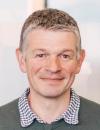David Hay
Group Leader and Professor of Tissue Engineering

- Institute for Regeneration and Repair
- Centre for Regenerative Medicine
Contact details
- Tel: 0131 651 9500
- Email: david.hay@ed.ac.uk
Address
- Street
-
Centre for Regenerative Medicine
Institute for Regeneration and Repair
The University of Edinburgh
Edinburgh BioQuarter
5 Little France Drive - City
- Edinburgh
- Post code
- EH16 4UU
Background
Dave is Professor of Tissue Engineering at the Institute for Regeneration and Repair (IRR), University of Edinburgh. He received his PhD from the University of St Andrews in 2000. Following this he worked as a postdoctoral researcher at Roslin Institute and the University of Edinburgh. In 2008, he secured a RCUK fellowship and started his own research group at the Centre for Regenerative Medicine. Dave has worked in the field of stem cell biology and differentiation for over 20 years. He and his team have highlighted the important role that pluripotent stem cells (PSCs) have to play in modelling human biology ‘in the dish’ and supporting failing liver function in vivo.
Qualifications
BSc (hons), PhD
Responsibilities & affiliations
2024-present Section Editor, Heliyon, Developmental Biology, Cell Press
2023-present Adjunct Professor, Zhejiang University, China
2023-present UKRI Interdisciplinary Assessment College Panel Member
2021-present Founder, Chairman and CEO, Stimuliver ApS
2020-present University of Edinburgh Senate Member
2017-present Chair of Tissue Engineering, University of Edinburgh
2016-present Co-Founder and Director, Stemnovate Limited, UK
Open to PhD supervision enquiries?
Yes
Current PhD students supervised
Ms Alvile Kasarinaite
Ms Kasia Stefaniak
Research summary
Liver Tissue Development and Engineering
The liver plays a vital role in human health, including the detoxification of foreign substances. We use stem cells to grow liver tissue in the laboratory. The stem cells we use are called human embryonic stem cells and induced pluripotent stem cells. The attraction of using these cell populations is their indefinite growth in the lab and their ability to form all the cells found in the human body. We have developed reliable methods for building human liver tissue. Encouragingly, it behaves in a similar way to the liver found in the human body. We believe our liver tissue has an important part to play in improving human drug development and repurposing; modelling human disease and in the future may provide an alternative source of human tissue to treat failing human liver function.
Knowledge exchange
https://www.thenakedscientists.com/articles/science-news/future-artificial-livers
https://www.stemcell.com/stemdiff-hepatocyte-kit.html
More video
- Measuring Lipid Accumulation in 3D Liver Cell Cultures
- Development of 3D Liver Spheroid Cultures and Tools for 3D Culture Metabolic Studies
- Ep. 216: “Liver Tissue Development & Engineering” Featuring Dr. David Hay
- Automation in advanced therapies
- Derivation of Metabolically Active Hepatocytes from Human Pluripotent Stem Cells
- Lab Grown Cells Offer Hope for New Liver Disease Treatments
In the press
UK-China Health Innovation Platform - https://www.ecns.cn/cns-wire/2025-08-08/detail-ihetyypn3671376.shtml
Newly founded stem cell company wants to spin gold on liver diseases - Nystiftet stamcelle-firma vil spinde guld på leversygdomme
Artificial liver progress - https://www.thenakedscientists.com/podcasts/short/artificial-liver-progress
The future for artificial livers - https://www.thenakedscientists.com/articles/science-news/future-artificial-livers
Growing human liver cells ‘in a dish’ - https://futurumcareers.com/growing-human-liver-cells-in-a-dish
3D printing offers hope of building human organs from scratch - https://www.ft.com/content/eabb0e00-9755-11e9-98b9-e38c177b152f
Liver success holds promise of 3D organ printing - https://www.ft.com/content/67e3ab88-f56f-11e7-a4c9-bbdefa4f210b
Stem cell innovators - https://biolamina.com/newsroom/stem-cell-innovator-david-hay/
Scientists find that smoking harms livers of unborn babies - https://www.bbc.co.uk/news/uk-scotland-40084844
Smoking during pregnancy may damage baby’s liver, finds study - https://www.hindustantimes.com/fitness/smoking-during-pregnancy-may-damage-baby-s-liver-finds-study/story-pD9G2GTmYSoVBzngSe726H.html
High-tech drug research gives us a fuller picture - http://www.ft.com/cms/s/2/6661db3e-5c6e-11e3-931e-00144feabdc0.html
Stem cells provide development aid - https://www.faz.net/aktuell/wissen/atomium-culture/medikamentenforschung-stammzellen-leisten-entwicklungshilfe-1623481.html
Stem cell research to speed delivery of new medicines - https://elpais.com/sociedad/2011/07/26/actualidad/1311631211_850215.html
Drugs screening stem cells plan - http://news.bbc.co.uk/1/hi/scotland/edinburgh_and_east/7231177.stm
